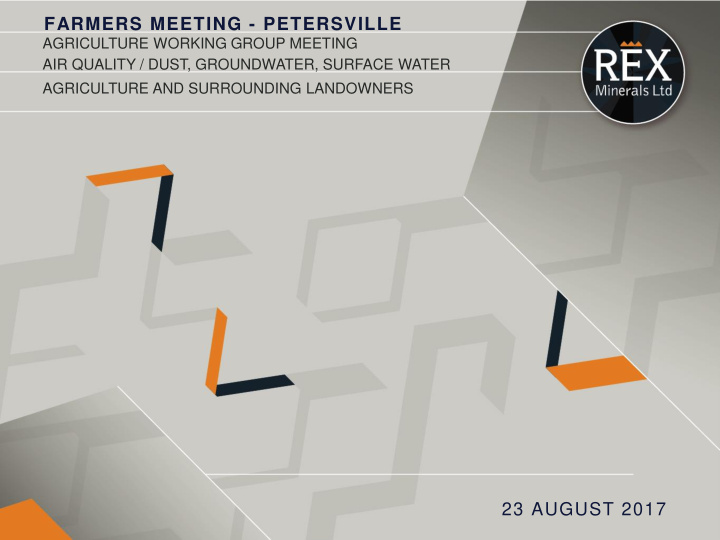



FARMERS MEETING - PETERSVILLE AGRICULTURE WORKING GROUP MEETING AIR QUALITY / DUST, GROUNDWATER, SURFACE WATER AGRICULTURE AND SURROUNDING LANDOWNERS 23 AUGUST 2017
DUST IN AGRICULTURE AIR QUALITY AND DUST 2
DUST IN AGRICULTURE RISK ASSESSMENT • Dust Sources • Haul Roads • In pit activities • TSF Construction • Dust Modelling • Well below license conditions • DPC and EPA reviewed previous modelling & set licence conditions • Maximum level at a receptor occurs when tailings dam height increase construction 3
DUST IN AGRICULTURE LICENCE CONDITIONS Summary of air quality compliance criteria Substance Criteria Units Averaging Period Reference Hillside Mine ML PM 10 50 µg/m 3 24 hours a Air NEPM Hillside Mine ML µg/m 3 PM 2.5 25 24 hours NEPM advisory reporting standard 8 c µg/m 3 PM 2.5 24 hours NEPM advisory reporting standard TSP 120 µg/m 3 24 hours Hillside Mine ML µg/m 3 TSP 90 12 months Hillside Mine ML 30 days (for annual TDD d g/(m 2 month) 2 Hillside Mine ML average) g/(m 2 month) TDD 4 12 months Hillside Mine ML TDD – Total Dust Deposited is most relevant to agriculture 4
DUST IN AGRICULTURE CONTROL MEASURES • Haul road material and construction. • Minimise disturbed areas. • Progressively rehabilitate land. • Water trucks and sprays. • Modify operations – change mining or dumping locations. • Risk management – predict high risk conditions and plan operations accordingly. • Early warning monitoring and operational adjustment. 5
DUST IN AGRICULTURE MONITORING Compliance Monitoring : • Dust onto & off the site. • PM 10 and TSP. • PM 2.5 for one year to evaluate levels. • Dust deposition monitoring. Early Warning Monitoring : • Additional operational monitoring within the site close to sources for operational management. • Informs operations of dust trends. • Alerts triggered. • Additional controls or changes to operation. 6
DUST IN AGRICULTURE MONITORING PLAN Monitoring network: • Focus on monitoring near receptors (residences). • Measure concentrations of PM 10 , TSP & PM 2.5 and dust deposition. • Locations - considering prevailing wind directions (including seasonal). 7
DUST IN AGRICULTURE DUST DEPOSITION GAUGES 8
GROUND WATER AND ADJACENT AGRICULTURE GROUND WATER 9
GROUNDWATER MANAGEMENT AND MONITORING PLAN HYDROGEOLOGY • Groundwater occurs in fractured basement rocks - basement rock aquifer. • Basement rock aquifer fresh to partially weathered. • Overlain by saprolitic (weathered) zone clays – confining layer. • Overlain by Tertiary age sediments – unsaturated (no aquifer). • Covered by topsoil. • Rain falling on YP infiltrates through the soil. • Water that has moved past the root zone then sits on top of the saprolite zone. • Then may infiltrate down into the formations over a long period of time, eventually reaching the basement aquifer. • Basement groundwater is saline to hypersaline – not used by agriculture • Moves very slowly from west to east. 10
GROUNDWATER MANAGEMENT AND MONITORING PLAN GEOLOGICAL CROSS SECTION Farmers get “first use” of rainfall 11
GROUNDWATER MANAGEMENT AND MONITORING PLAN HYDROGEOLOGY – BASEMENT AQUIFER WATER ELEVATIONS PRE-MINING 12
GROUNDWATER MANAGEMENT AND MONTORING PLAN OUTCOMES Strategies: • calibrated basement ground water model; • ongoing calibration of the transient ground water model using data obtained from groundwater monitoring; • ongoing calibration of the pit lake geochemistry and hydrogeological models using data obtained from operational monitoring; • monitoring of process plant functions, including tank levels, flow rates, pressures and fluid quantities; • groundwater monitoring – depth and quality 13
GROUNDWATER MANAGEMENT AND MONTORING PLAN HYDROGEOLOGY – MODELLED BASEMENT AQUIFER WATER ELEVATIONS AFTER 5 YEARS OF OPERATION 14
GROUNDWATER MANAGEMENT AND MONITORING PLAN DEFINITIONS Parameters to be monitored: • Depth to water or standing water level (SWL) – in metres below ground or a reference point. • SWL converted to water elevations AHD (approximate sea level) . • Water quality – Salinity, pH, Calcium, Magnesium, Potassium, Sodium, Sulphate, Chloride, Nitrate, Arsenic, Boron, Chromium, Cobalt, Copper, Iron, Manganese, Zinc, Antimony, Uranium, Total recoverable hydrocarbons (TRH) – 1 site only. 15
GROUNDWATER MANAGEMENT AND MONITORING PLAN LEADING GROUNDWATER CRITERIA Baseline monitoring data – groundwater (to be updated prior to mining operations) Diss. Chloride EC pH Diss. Arsenic Diss. Boron Cadmium Diss. Copper Diss. Zinc STATISTIC (mg/L) ( µ S/cm ) 6.2 0.001 1.7 0.0002 0.001 0.002 Min 9200 30000 7.8 0.05 5.5 0.0045 2.8 0.44 Max 58000 150000 7.11 0.01 3.82 0.001 0.244 0.24 Average 21500 63000 5.43* 0.034 6.05 0.002 1.453 0.182 AV+ 2SD 47469 127589 16
GROUNDWATER MANAGEMENT AND MONITORING PLAN PROPOSED MONITORING LOCATIONS Summary • No water table or unconfined aquifer • Basement aquifer confined by saprolite – low permeability • Cone of depression of basement aquifer only • Basement aquifer saline to hypersaline – no agricultural use • Farmers get first use of rainfall • Dewatering of basement aquifer does not impact available soil water 17
SUFACE WATER AND ADJACENT AGRICULTURE SURFACE WATER 18
SURFACE WATER MANAGEMENT AND MONTORING PLAN CURRENT LAND SURFACE - BASELINE CATCHMENT MODEL (1 IN A 100 YEAR FLOOD IN 6 HOURS) 19
SURFACE WATER MANAGEMENT AND MONTORING PLAN END OF MINE MODEL (1 IN A 100 YEAR FLOOD IN 6 HOURS) 20
SURFACE WATER MANAGEMENT AND MONTORING PLAN MANAGEMENT OF SURFACE WATER DURING OPERATIONS 21
SURFACE WATER MANAGEMENT AND MONITORING PLAN REPORTING • Key stakeholders will have access to relevant groundwater monitoring data. • These include Rex Minerals, State and Local government agencies, and the local community. • The Hillside Mine will report on the performance of the Surface Water Management Plan in the Annual Compliance Report (ACR), provide regular updates to members of the HMCV consultation group, and made available for public information on the Rex Minerals website. 22
CONTACT DETAILS STAY IN TOUCH www.rexminerals.com.au Website: community@rexminerals.com.au Email: PO Box 3435 Rundle Mall SA 5000 A: +61 (0) 8 82997100 T: rex@rexminerals.com.au E: 23
Recommend
More recommend